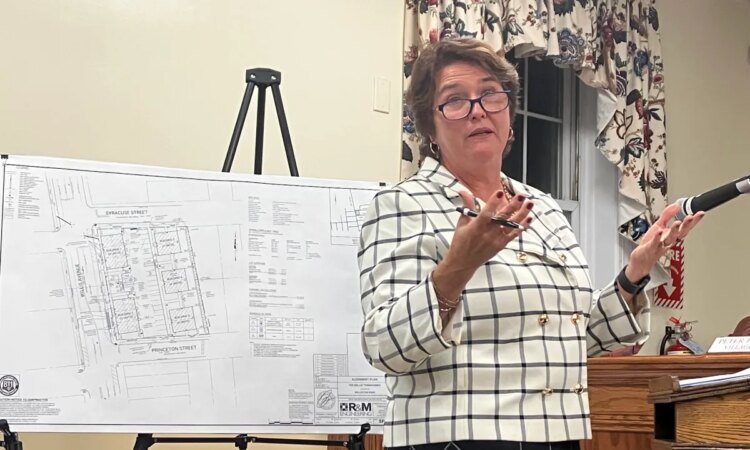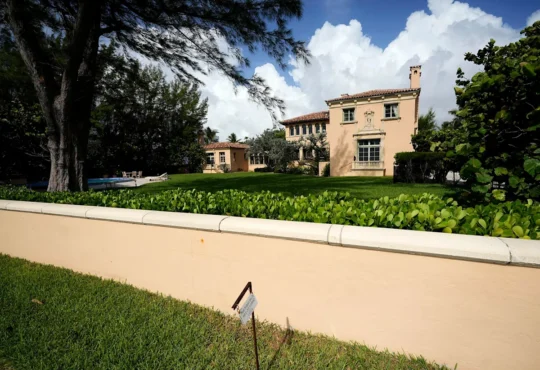Residents pack Williston Park Village Hall amid concern over proposed 18-unit townhouse project

In a standing-room-only meeting, over 75 residents filled Williston Park Village Hall on Monday, Oct. 20, to hear a proposal for 18 new rental units across five townhouses at 700 Willis Ave., where a TD Bank once stood.
The proposal was submitted by property owner Dean Poll, who has owned the lot for decades and previously operated restaurants like Papas and Riverbay at the location. It includes 36 parking spaces, the number required by the village code.
The roughly two dozen residents who spoke mostly said they were not against the land being developed as rental townhomes, but were concerned about the number of units, garbage collection, potential for increased traffic on residential Syracuse Street and whether the development was far enough away from neighboring residential homes on Syracuse and Princeton Streets according to town code and water usage.
“We’re not opposed to it,” said resident Frank Morrissey. “We just don’t want to run into any bad decisions that are going to make it untenable.”
Resident Umberto Mignardi said he thought the proposal required multiple variances that had not been obtained because he believed it did not comply with town code, In particular, he raised questions about the distance between the two townhomes in the back of the property and sidewalks across the street from neighboring homes on Syracuse and Princeton Streets, where he lives.
The current distance between the two homes at the back of the lot and the sidewalk is about six feet on the Princeton Street side and about 11 feet on the Syracuse Street side. Mignardi, who serves as the communications director for the Town of Hempstead, said he believed the distance between those homes and the sidewalk needed to be 20 feet, as that portion of the property abutted a residential district.
Kathleen Deegan Dickson, the developer’s attorney, said she thought Mignardi was mistaken. She said the 20-foot distance between the townhome and the sidewalk would only be required in a residential district if the property directly abuts another home or yard (here, it abuts the street first) and that it’s a rule that only applies to front yards, whereas this is a side yard.
Dickson held firmly that the proposal complied with all town and village codes.
Mayor Paul Ehrbar said the village, its building department, its attorney and the developer would be working together to determine the correct interpretation of the town code.
Migardi also said his calculations showed the property would collectively use 646,000 gallons of water a day, 46,000 more than the allowable 600,000 without a variance. Dickson and Ehrbar said they would also look into this concern in the coming weeks to determine its accuracy.
Dickson’s initial presentation called for each townhome to have a small garbage area adjacent to the building with one trash can per unit, and for those cans to be placed out on Syracuse Street for trash pickup.
After multiple residents said this would lead to too much trash on that street and create a disturbance for residents living there and schoolchildren waiting for the bus, she spoke with Poll and said the team would provide private trash pickup. This means that cans would not be placed on any street and a private service would come through and collect each can from each home’s garbage area, which residents and the board appeared to be agreeable to.
Residents also raised concern over the potential for increased traffic on residential Syracuse Street, which the presented plans showed as the only place residents would enter or exit the development.
Roughly a dozen residents brought up concerns over the entrance, saying it was a very narrow, crowded street that gets a great deal of traffic from school buses and Little League games, as it’s near a field. A handful consistently asked for there to be an egress on Willis Avenue. This, Dickson said, was determined to be dangerous by the county as it’s a busy main road.
Dickson said her team would work with the village board and residents to determine whether the egress should be on Syracuse Street, Princeton Street or both. She also said the developer would be open to placing a “no right turn” sign at the Syracuse Street exit, preventing people from driving down the street.
“Our position is that we’ll do an entrance on either street. We’ll do whichever makes most people happy,” Dickson said. “It makes no difference to us. We were trying to accommodate the residents.”
To those who raised concerns over an increase in overall traffic making driving in the area more inconvenient, Dickson referred to the traffic study conducted by the developer’s engineer, which showed that a residential use for the space would create four to ten times less traffic than the bank, which was previously there, two to seven times less traffic than a retail space, three to five times less than a medical office and half as much as an office.
“This property is going to get developed,” Dickson said. “I do understand the traffic situation, but I also understand the potential for a [different] development that would make that situation a lot worse.”
Others said they believed 18 units were too many, and asked Poll to consider 12 units, or to remove one of the five proposed townhomes.
“I hear you, but it doesn’t work financially,” Poll said. “It’s tight as it is right now.”
As the nearly three-hour meeting came to a close, Poll said he was committed to keeping the property in his family and creating an asset to the village where his family had operated businesses for the past 45 years.
“This is a great asset to the community. There will be a time when there’s going to be an extra car in front of you at the light,” Poll said, adding that the traffic would be much less than when the property was Riverbay. “We wanted to make something residential so it really complements the community. That was the whole idea…We hope to make something you are proud of.”
The board did not offer much opinion on the proposal, except to say they appreciated residents voicing their concerns, took them seriously and would be working to obtain answers in the coming weeks.
Mayor Paul Ehrbar led the board in a vote to adjourn the hearing to a later date, likely sometime this year or early next year.
“We’re adjourning because we can’t answer all of these questions right now,” Ehrbar said. “We’re looking to make this work best for everyone. ”
The mayor said the board was not selecting a date because trustees wanted to obtain all answers first so they could be sure the next meeting on the topic was productive.






